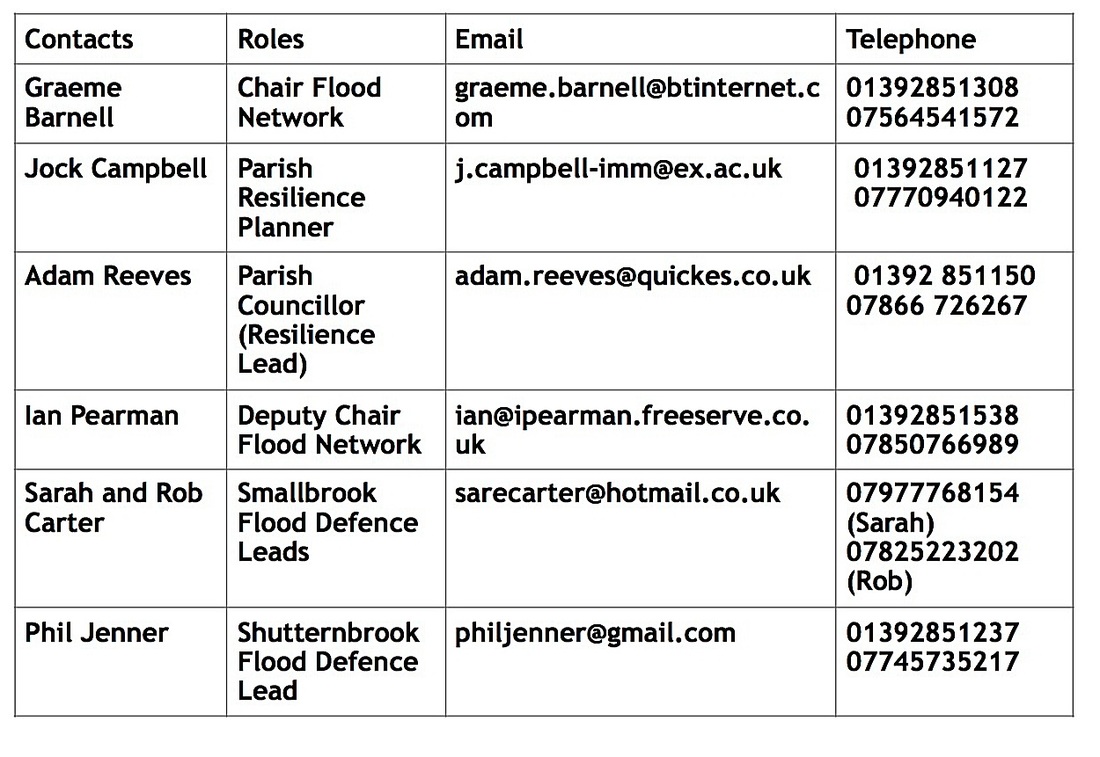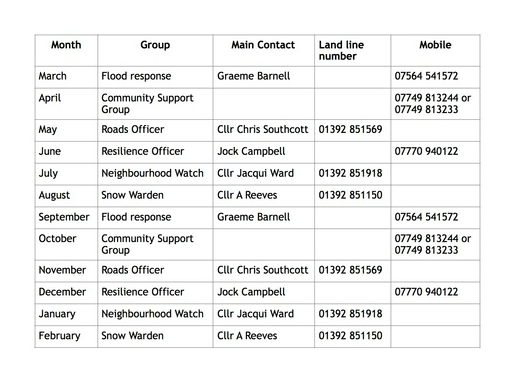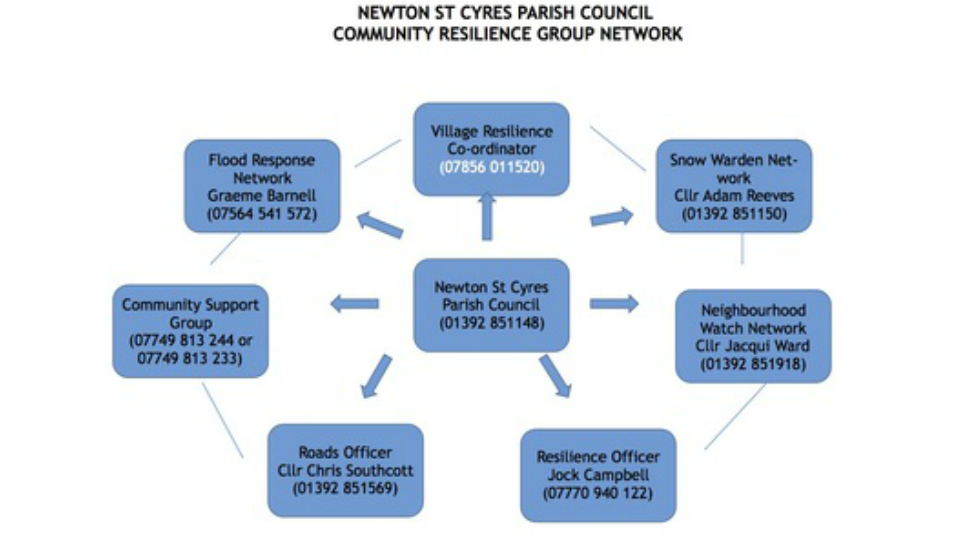Newton St Cyres Parish Council
Village Resilience Co-ordinator Rota
Mobile Phone number: 07856 011520
Main contacts named below will be responsible for ensuring that the mobile phone is moved to the next person on the rota.
Village Resilience Co-ordinator Rota
Mobile Phone number: 07856 011520
Main contacts named below will be responsible for ensuring that the mobile phone is moved to the next person on the rota.
Explanation on how the Network works
Newton St Cyres Parish Council is responsible for ensuring all the respective networks and groups work efficiently and will receive regular updates from each group and will appoint a Councillor to each network. Therefore taking overall responsibility for resilience in the village.
It is recognised that in an emergency affecting just one network or group, then contact would be direct with the person identified in the flow chart below It is important to have one central phone number in case of major emergencies and therefore, to ensure 24 hour cover, a mobile phone will be allocated to each network on a monthly basis in rotation. This therefore does not overburden one person acting as the main contact in the village.
The Parish Clerk will draw up a rota and ensure that it is updated on a regular basis. Please advise the Clerk of any amendments required to the rota.
The Resilience Officer will ensure that the Village Resilience Plan is kept up to date.
In the case of a major emergency, the Village Resilience Co-ordinator will phone both the Flood Warden network and the Snow Warden network and then they will cascade the information as indicated on the flow chart overleaf. This should enable a quicker response than the Village Resilience Co-ordinator phoning six different numbers.
It is recognised that in an emergency affecting just one network or group, then contact would be direct with the person identified in the flow chart below It is important to have one central phone number in case of major emergencies and therefore, to ensure 24 hour cover, a mobile phone will be allocated to each network on a monthly basis in rotation. This therefore does not overburden one person acting as the main contact in the village.
The Parish Clerk will draw up a rota and ensure that it is updated on a regular basis. Please advise the Clerk of any amendments required to the rota.
The Resilience Officer will ensure that the Village Resilience Plan is kept up to date.
In the case of a major emergency, the Village Resilience Co-ordinator will phone both the Flood Warden network and the Snow Warden network and then they will cascade the information as indicated on the flow chart overleaf. This should enable a quicker response than the Village Resilience Co-ordinator phoning six different numbers.
Parish Flood Defence Arrangements
Recent serious flooding in North of England and in Scotland has reminded us of the power of water to destroy homes and livelihoods. As we all know the River Creedy runs across the centre of the Parish. It is fed by several streams running down from the surrounding hills. Some of these streams run though areas of housing or very close to houses. Chief among these are the Smallbrook, the Shutternbrook and the Sweetham Brook. Normally these streams are small benign watercourses that add much to the attractiveness of the village and local countryside. However, as those who live close to these streams know, they can rapidly turn into torrents after prolonged and/or heavy rain. When this happens the streams has threatened homes and presented risk to life and limb particularly to the infirm and unwary. This includes pedestrians and motorists who try to drive though flood water. This is a particular risk when the Creedy overflows as it crosses Station Road.
In addition to the flooding threat from these watercourses persistent rain sometimes results in heavy run off of water from surrounding farmland that also contributes significantly to our difficulties.
Many will have clear memories of the autumn and winter of 2013/14 when parts of the parish were cut off for periods and a number of houses were either flooded or under serious threat of flooding.
Since that winter the Parish Council has responded to the concerns of residents and has reviewed local preparations and arrangements for flood defence. This is part of a local Contingency Planning initiative to ensure we have a local plans and arrangements to protect local people and to support emergency services whenever a critical incident occurs in the Parish.
The Parish now has an up to date Contingency Plan that sets out the key risks faced by the Parish from untoward incidents and details the arrangements that are in place to deal with them. A copy of this document is available either on the Parish website or from the Clerk to the Parish council.
As part of this Contingency Plan the Parish Council has established a local Flood Network. The network comprises local residents who have volunteered to work together to mitigate the risk of flooding in the Parish. The Flood Network has been meeting now for over a year. To date its work has involved:
Contacts:-
For further information or advice please contact us.
Recent serious flooding in North of England and in Scotland has reminded us of the power of water to destroy homes and livelihoods. As we all know the River Creedy runs across the centre of the Parish. It is fed by several streams running down from the surrounding hills. Some of these streams run though areas of housing or very close to houses. Chief among these are the Smallbrook, the Shutternbrook and the Sweetham Brook. Normally these streams are small benign watercourses that add much to the attractiveness of the village and local countryside. However, as those who live close to these streams know, they can rapidly turn into torrents after prolonged and/or heavy rain. When this happens the streams has threatened homes and presented risk to life and limb particularly to the infirm and unwary. This includes pedestrians and motorists who try to drive though flood water. This is a particular risk when the Creedy overflows as it crosses Station Road.
In addition to the flooding threat from these watercourses persistent rain sometimes results in heavy run off of water from surrounding farmland that also contributes significantly to our difficulties.
Many will have clear memories of the autumn and winter of 2013/14 when parts of the parish were cut off for periods and a number of houses were either flooded or under serious threat of flooding.
Since that winter the Parish Council has responded to the concerns of residents and has reviewed local preparations and arrangements for flood defence. This is part of a local Contingency Planning initiative to ensure we have a local plans and arrangements to protect local people and to support emergency services whenever a critical incident occurs in the Parish.
The Parish now has an up to date Contingency Plan that sets out the key risks faced by the Parish from untoward incidents and details the arrangements that are in place to deal with them. A copy of this document is available either on the Parish website or from the Clerk to the Parish council.
As part of this Contingency Plan the Parish Council has established a local Flood Network. The network comprises local residents who have volunteered to work together to mitigate the risk of flooding in the Parish. The Flood Network has been meeting now for over a year. To date its work has involved:
- The funding and setting up of three Flood Stores at strategic points in the Parish adjacent to key flood risk areas. The stores contain a variety of equipment and supplies that will be of use in the eventuality of flooding. This includes a supply of Aquasacs and plastic sheeting. We have purchased Aquasacs in preference to sand bags as sand bags take too long to fill given that local watercourses rise fast (and need two strong people to fill them). The Stores also have a supply of road signs and road lights in each.
- Establishing a network of volunteer wardens in different parts of the Parish trained to liaise with emergency services and support neighbours when floods threaten. We now have a network of six wardens but definitely need more.
- A local tipping rain gauge that signals warnings electronically to Flood Network members if pre-set rainfall thresholds are breached. This is set up.
- Working with local homeowners and landowners to clear the banks of watercourses and obstructions and rubbish in the watercourses themselves. This has mostly been achieved but will need continuing vigilance
- Working with the local authorities to identify and reduce flood risks. This involves working with Mid Devon Council and Devon County Council to address key flood risks along the Shutternbrook and the Smallbrook. Mid Devon has recently carried out separate surveys of the risks for each of these watercourses and we are in discussions with Mid Devon about the work that is required to address the main concerns identified.
Contacts:-
For further information or advice please contact us.


